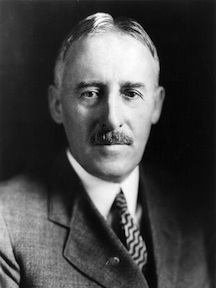By Tyler D. Nelson
Henry L. Stimson was an influential American statesman during the first half of the 20th century. Born in New York on September 21, 1867, he attended Yale University, where he achieved great academic success, graduating third in his class in 1888 and earning election into Phi Beta Kappa. Following his studies at Yale, Stimson enrolled at Harvard Law School, finishing his degree in 1890. His time at both institutions had a major impact on his personal philosophy, teaching him the importance of impartial and considerate debate, both of which he would exemplify throughout his professional life.
After a successful legal career fighting corporate and governmental corruption, Stimson was appointed Secretary of War by William Howard Taft in 1911 and worked extensively to unite the Republican Party, then divided between Taft and Theodore Roosevelt. He later served in the State Department, where he advocated for peaceful diplomacy first as an envoy to Latin America from 1918 to 1926 and eventually as Hoover’s Secretary of State. As the State Department notes, his negotiations as an envoy include helping to end a territorial dispute between Peru and Chile, as well as peacefully resolving a civil war in Nicaragua, where he employed the non-partisan approach he learned as a student to settle a major political disagreement between liberals and conservatives. Due to his massive achievements in peaceful diplomacy, Hoover appointed Stimson Secretary of State in 1929. During this administration, he led the U.S. delegations to the London Naval Conference in 1930 and the 1932 Geneva Disarmament Convention, both of which sought to limit the build-up of militaries in order to prevent armed conflict. Additionally, he issued the Stimson Doctrine, essentially declaring that the U.S. would not acknowledge acts of aggression as reasonable excuses to disregard the terms of international treaties.
Stimson’s diplomatic capabilities led Franklin D. Roosevelt, hoping to foster a bipartisan approach to the growing threat of global war, to appoint him Secretary of War in 1940. As acting Secretary for FDR, Stimson had a substantial influence on America’s foreign and diplomatic policy during WWII. He played a central role in the controversial decision to relocate over 120,000 Japanese–Americans to interment camps following the December 1941 attack on Pearl Harbor. He also oversaw the Manhattan Project and the committee that voted to deploy nuclear weapons on Hiroshima and Nagasaki in August of 1945. While these actions are part of dark chapter in American history and potentially marring to Stimson’s legacy, it is important to note that even when enacting world-changing policies, he still kept his ideals of peaceful resolution in focus. Despite his belief in the necessity of developing atomic weaponry to end the war, Stimson was extremely cautious to utilize nuclear power without first warning Japan of its existence, instead seeking to reach a more peaceful agreement and avoid force if possible. Further, he directed the committee to remove Kyoto from the target list, recognizing it as an important cultural and economic center whose destruction would likely result in the near, if not total, death of Japanese civilization. Stimson spent the final years of his career advocating against further development of nuclear weapons in favor of a more peaceful application of the Manhattan Project’s atomic discoveries. He suffered a heart attack and died in his Long Island home on October 20, 1950.
Stimson’s peace-seeking and non-partisan legacy continues to this day at the Stimson Center, a diplomatic think tank in Washington, D.C. According to the Center’s website, the research done at Stimson seeks “to address borderless threats through collective action” following its namesake’s model of “taking pragmatic steps toward ideal solutions.” Winning several accolades and acclaim from both sides of the political aisle, the center’s research seeks non–partisan solutions to a wide variety of geopolitical issues such as the implications of military drone use, weapon proliferation, and environmental stability. Certainly, there is no better tribute to one of American’s most influential diplomatic figures than the innovative work performed at the Center, where Stimson’s legacy lives on in the impartiality and careful consideration employed to achieve the peaceful resolution of the greatest problems facing the world today.
Tyler D. Nelson is a senior at Creighton University majoring in English and minoring in biology. Creighton is home to the Beta of Nebraska Chapter of Phi Beta Kappa.
Photo at top: Henry L. Stimson, July 23, 1931.




